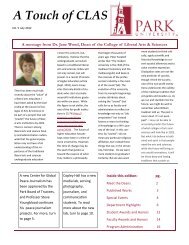How to Write a Radio Serial Drama for Social Development- PDF
How to Write a Radio Serial Drama for Social Development- PDF
How to Write a Radio Serial Drama for Social Development- PDF
Create successful ePaper yourself
Turn your PDF publications into a flip-book with our unique Google optimized e-Paper software.
188 Chapter Thirteen: The Value of Editing<br />
The original version expressed little or no emotion, and the excitement at the<br />
end of the scene came <strong>to</strong>o late <strong>to</strong> keep the audience involved. The edited<br />
version grabs the audience’s attention earlier, provides a sense of caring that<br />
invites an emotional response from the audience, and suggests that there is<br />
more <strong>to</strong> the lives of the characters than being mouthpieces <strong>for</strong> the drama’s<br />
message.<br />
• The first sound effect (FX) of the child screaming was added <strong>to</strong> tie this<br />
episode <strong>to</strong> the previous one and <strong>to</strong> demonstrate that, in reality, life does<br />
not occur in discrete, separate events. One event does not s<strong>to</strong>p just<br />
because another one is occurring. The question of Razia’s engagement<br />
has not gone away just because Chauhdri and Shaista are now discussing<br />
a women’s center. The sound effect also adds some suspense <strong>to</strong> the scene,<br />
since the audience cannot tell whether it is simply a child being naughty<br />
or a hint that a serious dramatic conflict is about <strong>to</strong> erupt.<br />
• Razia’s s<strong>to</strong>ry involves the audience in the scene, even if, at this stage, the<br />
idea of a women’s center is not particularly interesting <strong>to</strong> them. They are<br />
hooked in<strong>to</strong> the scene <strong>to</strong> find out how it will end. At the same time, they<br />
are absorbing, even if inadvertently, the beginning of the message on the<br />
value of women’s income generating groups.<br />
• Sound effects are added later in the scene <strong>to</strong> maintain the suspense and<br />
<strong>to</strong> give Chauhdri and Shaista the opportunity <strong>to</strong> repeat, in a perfectly<br />
natural way, the message from the previous episode.<br />
• The new ending is a cliffhanger. When the episode ends, the audience<br />
does not know whether Razia will be all right. They must tune in again<br />
next time <strong>to</strong> find out what will happen. It is not necessary that every<br />
scene contain such a potentially unhappy ending, but every scene should<br />
contain some spark of real life, some suggestion that there is more <strong>to</strong> the<br />
lives of the characters than being mouthpieces and recipients of the<br />
message.<br />
Editing <strong>to</strong> Clarify Scene Emotion<br />
Emotion is vital <strong>for</strong> audience involvement, but how does the writer add<br />
emotion <strong>to</strong> a scene that, on the surface, is no more than a conversation<br />
between two characters This is the problem in the following scene from the<br />
Nepali Distance Education Series, Service Brings Reward. The characters<br />
include:<br />
Kamala (abbreviated as KAM), the health worker in Pipaltar village;<br />
Seti, A respected older woman of the village;<br />
Rama, Sister-in-law <strong>to</strong> Seti, who lives in another part of the country;<br />
and,<br />
Madhukar (abbreviated as MADHU), the post’s health assistant.<br />
Namaste is a Nepali word of greeting used when people meet or when<br />
they part. Nani is a term of affection used by an older woman speaking <strong>to</strong> a<br />
younger woman.
















